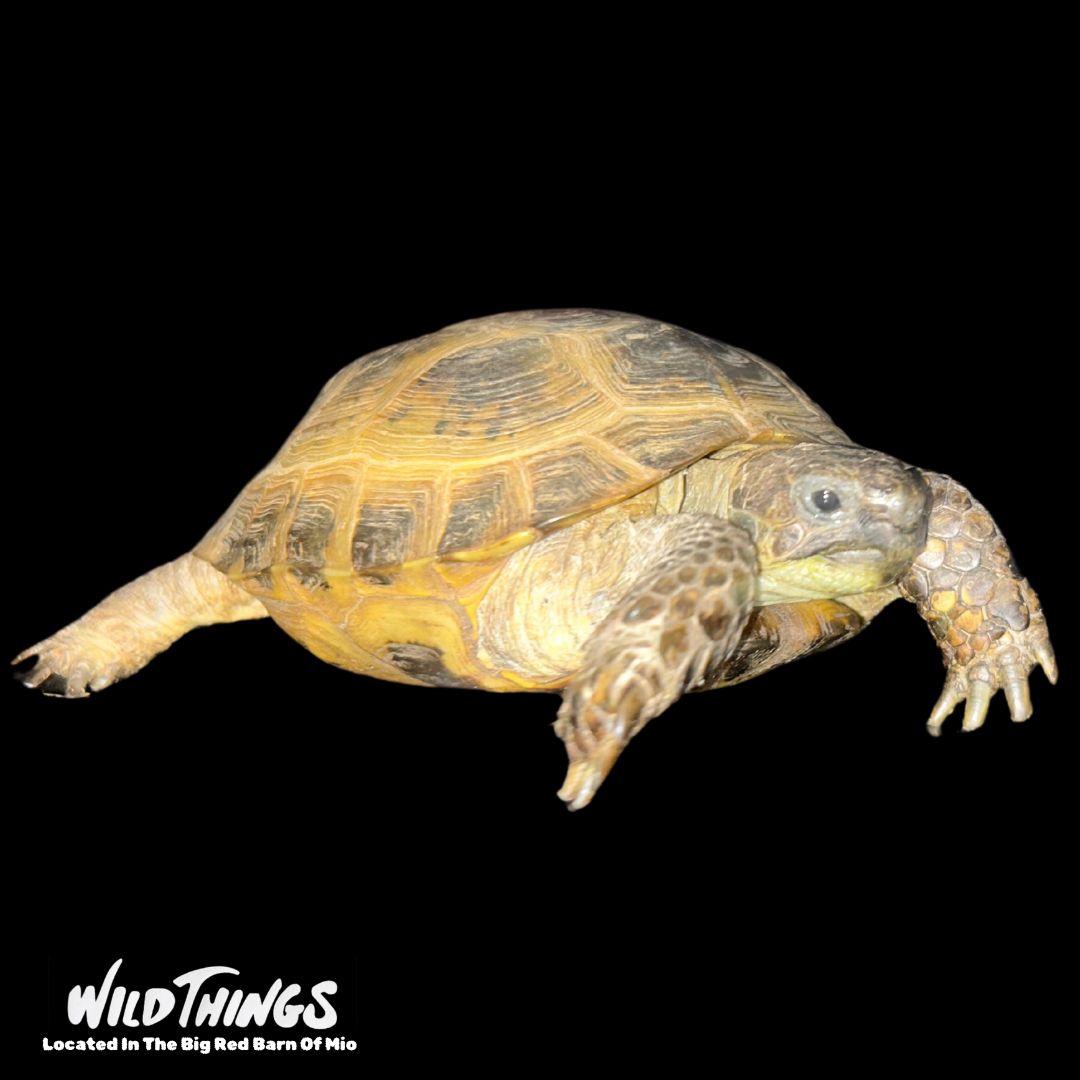AuSable River Outdoors
Russian Tortoise
Russian Tortoise
Couldn't load pickup availability
Species: Russian Tortoise
Scientific Name: Estudo Horsfieldii
Origin: Russian tortoises are native to central Asia, where they can be found in Kazakhstan, Uzbekistan, Turkmenistan, Kyrgyzstan, Afghanistan, and the northeastern edge of Iran.
Lifespan: Up to 50 years, or possibly more.
Size: 5-10 Inches In Length
Enclosure Type: Tortoise tables, large plastic tubs, or custom-built enclosures are good options.
Enclosure Size: Considering that Russian tortoises generally max out around 10 In, and the smaller males are more active than females, the minimum recommended enclosure size for one Russian tortoise is 7’L x 3.5’W x 2’H, or 24.5 square feet of floor space.
Substrate: For Russian tortoises, it’s best to use a well-drained, naturalistic substrate that is similar to what is found in their native habitat. This substrate should be layered at least 4″ deep to allow for burrowing behavior for juveniles, and 6″ for adults. Here are some good options for substrate: DIY arid mix: 40% organic topsoil, 40% play sand, 20% Zoo Med Excavator Clay, Zoo Med ReptiSand Or Exo Terra Desert Sand.
Décor: Decorations play a vital role in your Russian tortoise’s enclosure as environmental enrichment. Enrichment items encourage exercise, stimulate your pet’s natural instincts, and help promote overall wellbeing. Some good choices for décor are: Hollow logs, cork flats, flat stones, dirt mounds, and edible, drought-resistant plants.
Water: Your tortoise should have access to clean drinking water at all times. They tend to dirty the water quickly, so you will need to replace the water daily and give it a good scrub with animal-safe disinfectant weekly. A large flower pot saucer, sunk into the substrate for easy access, makes for a good water dish. The water should be no deeper than your tortoise’s knees. Juvenile tortoises should be soaked in shallow, lukewarm water for 10-15 minutes 2x/week to make sure that they are adequately hydrated.
Temperature: You will need at least one halogen heat lamp to properly heat your tortoise.
• Basking area temperature: 95°F / 35°C
• Cool zone temperature: 75-85°F / 24-29°C
• Nighttime temperature: 70-75°F / 21- 23°C
Humidity: For juvenile Russian tortoises, the entire enclosure should be kept more humid than required for an adult. Target humidity should be between 40-75%, lower during the day and higher at night. To increase humidity levels in the enclosure, use a handheld pressure sprayer to moisten the substrate first thing in the morning. Avoid spraying the tortoise directly.
Lighting: Russian tortoises are diurnal, which means that they are most active during the day. This also means that they need exposure to bright light and UVB during the day to maintain good mental and physical health. Light sources should be left on for 14 hours/day during summer and 10 hours/day during winter to replicate natural seasonal rhythms.
A UVB bulb isn’t bright enough to replicate daylight. To get a little closer to this goal, you will need to supplement with a bright, 6500K T5 HO fluorescent or LED lamp, long enough to span 3/4 to the full length of the enclosure. This is particularly important if you are using live plants, but it is also valuable for supporting your tortoise’s general wellbeing.
Type Of Diet: Russian tortoises are herbivores, which means that they eat plants. Russian tortoises require a high-fiber, low-protein, low-sugar diet for best health. This means that their diet should be primarily comprised of leafy greens, grasses, and edible “weeds” rather than the kinds of vegetables you get from the produce section of the grocery store. The key to providing your pet with balanced nutrition is VARIETY! So make it your goal to provide as many different kinds of foods to your pet tortoise as possible.
Types Of Food: Appropriate greens for Russian tortoises include: Alfalfa, Aloe vera, Bermuda grass, Celery leaves, Chicory, Clover, Daisy, Dandelion, Endive, Escarole, Geranium, Grape leaves, Hibiscus, Honeysuckle, Mallow, Mulberry leaves, Nasturtium, Opuntia cactus, Petunia, Plantain leaves, Romaine lettuce, Thistle, Timothy grass, Violet, Watercress.
Flowers make a nutritious tortoise treat that is safe to feed more frequently than what most people like to use for treats (i.e. fruit). Here are some options: Clover, Daisy, Dandelion, Geranium, Hibiscus, Honeysuckle, Mallow, Nasturtium, Petunia, Squash flowers & Violet
Fruits and feeder insects can also be offered, but only as very rare treats as they have high sugar content.
Feeding Schedule: Young and growing Russian tortoises should be given as much as they can eat every day. Once they near adulthood, this should be reduced to a limited quantity (roughly the same size as their shell) daily to prevent obesity.
Supplements: To make sure your tortoise is getting the right nutrients in its diet, it’s a good idea to sprinkle its food with supplement powder. You will also need to provide a cuttlebone in the enclosure. Aside from being a good source of calcium, it also helps keep your tortoise’s beak trimmed!
Share

